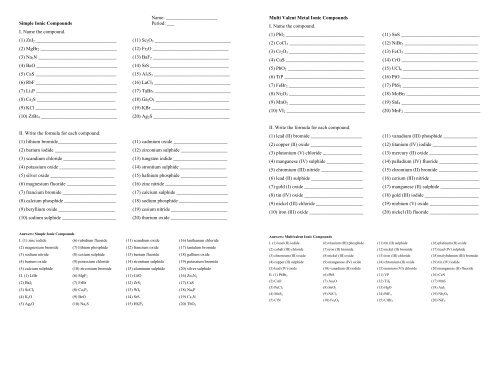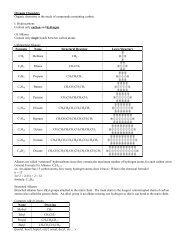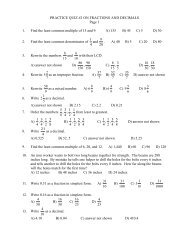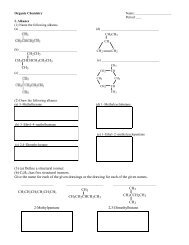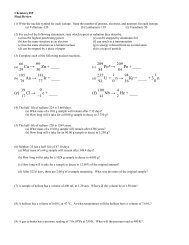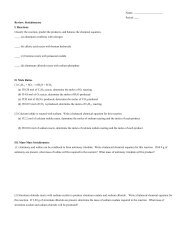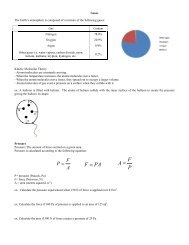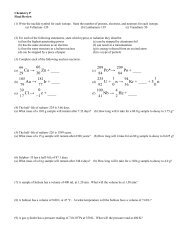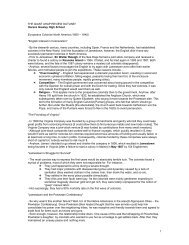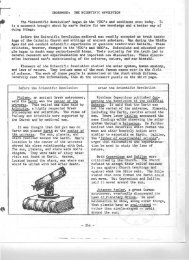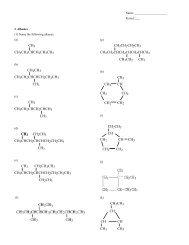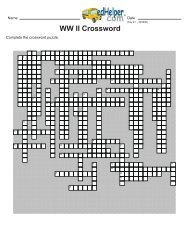I. Name the compound. - yourhomework.com Home Page
I. Name the compound. - yourhomework.com Home Page
I. Name the compound. - yourhomework.com Home Page
- No tags were found...
Create successful ePaper yourself
Turn your PDF publications into a flip-book with our unique Google optimized e-Paper software.
<strong>Name</strong>: _____________________Simple Ionic Compounds Period: ___I. <strong>Name</strong> <strong>the</strong> <strong><strong>com</strong>pound</strong>.(1) ZnI 2 _________________________________(2) MgBr 2 _______________________________(3) Na 3N ________________________________(4) BaO _________________________________(5) CaS _________________________________(6) RbF _________________________________(7) Li 3P _________________________________(8) Cs 2S ________________________________(9) KCl _________________________________(10) ZrBr 4 _______________________________(11) Sc 2 O 3 _______________________________(12) Fr 2O _______________________________(13) BaF 2 _______________________________(14) SrS ________________________________(15) Al 2S 3 _______________________________(16) LaCl 3 _______________________________(17) TaBr 5 _______________________________(18) Ga 2O 3 ______________________________(19) KBr ________________________________(20) Ag 2S _______________________________II. Write <strong>the</strong> formula for each <strong><strong>com</strong>pound</strong>.(1) lithium bromide________________________(2) barium iodide _________________________(3) scandium chloride _____________________(4) potassium oxide _______________________(5) silver oxide __________________________(6) magnesium fluoride ____________________(7) francium bromide ______________________(8) calcium phosphide _____________________(9) beryllium oxide _______________________(10) sodium sulphide ______________________Answers: Simple Ionic CompoundsI. (1) zinc iodide(6) rubidium fluoride(2) magnesium bromide (7) lithium phosphide(3) sodium nitride(8) cesium sulphide(4) barium oxide(9) potassium chloride(5) calcium sulphide (10) zirconium bromideII. (1) LiBr(6) MgF 2(2) BaI 2(7) FrBr(3) ScCl 3(8) Ca 3P 2(4) K 2O(9) BeO(5) Ag 2O(10) Na 2S(4) MnS2(9) NiCl3(14) SrS(19) Cs 3N(5) CrN(10) Fe2O3(15) Hf 3P 4(20) ThO 2Multi Valent Metal Ionic CompoundsI. <strong>Name</strong> <strong>the</strong> <strong><strong>com</strong>pound</strong>.(1) PbI 2 ________________________________(2) CoCl 3 _______________________________(3) Cr 2O 3 _______________________________(4) CuS ________________________________(5) PbO 2 _______________________________(6) TiP _________________________________(7) FeBr 2 _______________________________(8) Ni 2O 3 _______________________________(9) MnO 2 _______________________________(10) VI 2 ________________________________II. Write <strong>the</strong> formula for each <strong><strong>com</strong>pound</strong>.(1) lead (II) bromide _____________________(11) cadmium oxide ______________________(12) zirconium sulphide ___________________(13) tungsten iodide ______________________(14) strontium sulphide ___________________(15) hafnium phosphide ___________________(16) zinc nitride _________________________(17) calcium sulphide _____________________(18) sodium phosphide ____________________(19) cesium nitride _______________________(2) copper (II) oxide _____________________(3) plutonium (V) chloride ________________(4) manganese (IV) sulphide _______________(5) chromium (III) nitride _________________(6) lead (II) sulphide _____________________(7) gold (I) oxide ________________________(8) tin (IV) oxide ________________________(9) nickel (III) chloride ___________________(10) iron (III) oxide ______________________(20) thorium oxide _______________________Answers: Multivalent Ionic Compounds(11) scandium oxide (16) lanthanum chlorideI. (1) lead (II) iodide(6) titanium (III) phosphide(12) francium oxide(17) tantalum bromide(2) cobalt (III) chloride(7) iron (II) bromide(13) barium fluoride (18) gallium oxide(3) chromium (III) oxide (8) nickel (III) oxide(14) strontium sulphide (19) potassium bromide(4) copper (II) sulphide(9) manganese (IV) oxide(15) aluminum sulphide (20) silver sulphide(5) lead (IV) oxide(10) vanadium (II) iodide(11) CdO(16) Zn 3 N 2II. (1) PbBr2(6) PbS(12) ZrS 2(17) CaS(2) CuO(7) Au2O(13) WI 6(18) Na 3P(3) PuCl 5(8) SnO 2(11) SnS ________________________________(12) NiBr 2 ______________________________(13) FeCl 3 ______________________________(14) CrO _______________________________(15) UCl 6 _______________________________(16) PtO ________________________________(17) PbS 2 _______________________________(18) MoBr 3 ______________________________(19) SnI 4 ________________________________(20) MnF 2 _______________________________(11) vanadium (III) phosphide ______________(12) titanium (IV) iodide __________________(13) mercury (II) oxide ____________________(14) palladium (IV) fluoride ________________(15) chromium (II) bromide ________________(16) cerium (III) nitride ____________________(17) manganese (II) sulphide ________________(18) gold (III) iodide ______________________(19) niobium (V) oxide ____________________(20) nickel (II) fluoride ____________________(11) tin (II) sulphide(16) platinum (II) oxide(12) nickel (II) bromide(17) lead (IV) sulphide(13) iron (III) chloride(18) molybdenum (III) bromide(14) chromium (II) oxide (19) tin (IV) iodide(15) uranium (VI) chloride (20) manganese (II) fluoride(11) VP(16) CeN(12) TiI4(17) MnS(13) HgO(18) AuI 3(14) PdF4(19) Nb2O5(15) CrBr2(20) NiF2
Polyatomic CompoundsReview: Ionic CompoundsI. <strong>Name</strong> <strong>the</strong> <strong><strong>com</strong>pound</strong>.I. <strong>Name</strong> <strong>the</strong> <strong><strong>com</strong>pound</strong>.(1) NaNO 3 ______________________________(11) CuS 2O 3 _____________________________(1) MgCl 2 _______________________________(11) Cr(IO 3) 2 _____________________________(2) Mg(OH) 2 ____________________________(12) Ni(IO 3) 3 ____________________________(2) AlF 3 ________________________________(12) V(C 2H 3O 2) 2 __________________________(3) CaCO 3 ______________________________(13) ScPO 3 ______________________________(3) CrBr 3 _______________________________(13) SnS ________________________________(4) KMnO 4 _____________________________(14) HgClO 2 _____________________________(4) Ca(NO 2) 2 ____________________________(14) ZnCO 3 ______________________________(5) Sr(NO 2) 2 ____________________________(15) Ag 2C 2O 4 ____________________________(5) NaOH _______________________________(15) MoCl 3 ______________________________(6) NH 4 Cl ______________________________(16) BaHPO 4 _____________________________(6) ZnCrO 4 ______________________________(16) HgF ________________________________(7) LiClO 3 ______________________________(17) Cr(C 2H 3O 2) 3 _________________________(7) CuBr ________________________________(17) U(BrO) 4 ____________________________(8) KCN ________________________________(18) (NH 4) 2SO 4 ___________________________(8) Li 3PO 3 ______________________________(18) ScBO 3 ______________________________(9) Ba 3(PO 4) 2 ____________________________(19) Fe(OCN) 3 ___________________________(9) Zr(NO 3) 4 _____________________________(19) Cs 2O _______________________________(10) SrCO 2 ______________________________(20) V(HSO 3) 2 ___________________________(10) Fe 2O 3 _______________________________(20) Ti 3(PO 4) 4 ____________________________II. Write <strong>the</strong> formula for each <strong><strong>com</strong>pound</strong>.II. Write <strong>the</strong> formula for each <strong><strong>com</strong>pound</strong>.(1) barium sulphate ________________________(11) vanadium (III) iodate __________________(1) aluminum sulphide ____________________(11) nickel (III) arsenate ___________________(2) ammonium sulphide ____________________(12) iron (III) hydrogen carbonate ____________(2) barium fluoride _______________________(12) gold (I) bromide _____________________(3) potassium hydroxide ____________________(13) tin (IV) nitrite ________________________(3) scandium nitride ______________________(13) ammonium hydroxide _________________(4) lithium carbonate ______________________(14) rubidium hypochlorite _________________(4) sodium bromite _______________________(14) copper (II) carbonate __________________(5) zirconium iodite _______________________(15) manganese (II) bromate ________________(5) manganese (II) iodide __________________(15) calcium oxalate ______________________(6) sodium hydrogen sulphite ________________(16) titanium (III) nitrate ___________________(6) lithium phosphide _____________________(16) gallium sulphate ______________________(7) nickel (II) oxalate ______________________(17) cobalt (II) phosphate ___________________(7) strontium sulphite _____________________(17) yttrium bromide ______________________(8) chromium (II) acetate ___________________(18) strontium borate ______________________(8) beryllium nitrate ______________________(18) platinum (II) perchlorate ________________(9) cesium dihydrogen phosphate ____________(19) mercury (II) carbonite __________________(9) rubidium hydrogen phosphate ____________(19) cesium cyanide _______________________(10) scandium borate ______________________(20) beryllium cyanide _____________________(10) lead (IV) iodate ______________________(20) osmium (IV) oxide ___________________Answers: Polyatomic CompoundsI. (1) sodium nitrate(6) ammonium chloride(2) magnesium hydroxide (7) lithium chlorate(3) calcium carbonate(8) potassium cyanide(4) potassium permanganate (9) barium phosphate(5) strontium nitrite(10) strontium carbonite(11) copper (II) thiosulphate(12) nickel (III) iodate(13) scandium phosphite(14) mercury (I) chlorite(15) silver oxalate(16) barium hydrogen phosphate(17) chromium (III) acetate(18) ammonium sulphate(19) iron (III) cyanate(20) vanadium (II) hydrogensulphiteAnswers: Review Ionic CompoundsI. (1) magnesium chloride (6) zinc chromate(2) aluminum fluoride(7) copper (I) bromide(3) chromium (III) bromide (8) lithium phosphite(4) calcium nitrite(9) zirconium nitrate(5) sodium hydroxide(10) iron (III) oxideII. (1) Al2S3(6) Li3P(11) chromium (II) iodate(12) vanadium (II) acetate(13) tin (II) sulphide(14) zinc carbonate(15) molybdenum (III) chloride(11) NiAsO4(16) mercury (I) fluoride(17) uranium (IV) hypobromite(18) scandium borate(19) cesium oxide(20) titanium (IV) phosphate(16) Ga2(SO4) 3II. (1) BaSO4(2) (NH4)2S(3) KOH(4) Li2CO3(6) NaHSO3(7) NiC2O4(8) Cr(C2H3O2) 2(9) CsH2PO4(11) V(IO3)3(12) Fe(HCO3)3(13) Sn(NO2)4(14) RbClO(16) Ti(NO3) 3(17) Co3(PO4)2(18) Sr3(BO3) 2(19) HgCO2(2) BaF2(3) ScN(4) NaBrO2(5) MnI 2(7) SrSO3(8) Be(NO3)2(9) Rb2HPO4(10) Pb(IO 3 ) 4(12) AuBr(13) NH4OH(14) CuCO3(15) CaC 2 O 4(17) YBr3(18) Pt(ClO4) 2(19) CsCN(20) OsO 2(5) Zr(IO2) 4(10) ScBO3(15) Mn(BrO3)2(20) Be(CN)2
AcidsI. <strong>Name</strong> <strong>the</strong> acid.(1) HCl _________________________________(2) HNO 3 _______________________________(3) H 3PO 3 _______________________________(4) HCN ________________________________(5) H 2 SO 3 _______________________________<strong>Name</strong>: _____________________Period: ___(6) HC 2H 3O 2 _____________________________(7) HClO 3 _______________________________(8) H 2CO 3 _______________________________(9) H 3AsO 4 ______________________________(10) HIO 2 _______________________________Review: Covalent Compounds and AcidsI. <strong>Name</strong> <strong>the</strong> <strong><strong>com</strong>pound</strong>.(1) HI __________________________________(2) H 2 __________________________________(3) PBr 5 _________________________________(4) HIO 3 ________________________________(5) CS 2 _________________________________(6) P 2 S 3 _________________________________(7) NI 3 _________________________________(8) CF 4 _________________________________(9) HClO _______________________________(10) N 2H 4 _______________________________(11) HOCN _____________________________(12) H 2 C 2 O 4 _____________________________II. Write <strong>the</strong> formula for each acid.(1) hydrofluoric acid _______________________(2) phosphoric acid ________________________(3) nitrous acid ___________________________(4) sulphuric acid _________________________(5) oxalic acid ____________________________(6) hydroiodic acid ________________________(7) bromic acid ___________________________(8) chlorous acid __________________________(9) periodic acid __________________________(10) carbonous acid _______________________II. Write <strong>the</strong> formula for each <strong><strong>com</strong>pound</strong>.(1) perchloric acid ________________________(2) silicon tetrabromide ____________________(3) tetraphosphorus octasulphide _____________(4) boron triiodide ________________________(5) phosphorus pentafluoride ________________(6) arsenous acid __________________________(7) tetraphosphorus decoxide _______________(8) carbon tetrachloride ___________________(9) hydrosulphuric acid ___________________(10) dinitrogen tetrasulphide _______________(11) sulphur hexaiodide ___________________(12) boric acid ___________________________Covalent CompoundsI. <strong>Name</strong> <strong>the</strong> <strong><strong>com</strong>pound</strong>.(1) N 2O 3 _______________________________(2) P 2O 4 _______________________________(3) SO 3 ________________________________(4) IF 5 _________________________________(5) SiCl 4 _______________________________(6) Cl 2 _________________________________(7) PCl 3 ________________________________(8) PI 3 _________________________________(9) F 2O 2 ________________________________(10) CO 2 ________________________________(11) SF 6 ________________________________(12) O 2 _________________________________(13) PF 5 ________________________________(14) CO ________________________________Answers: AcidsI. (1) hydrochloric acid(2) nitric acid(3) phosphorous acid(4) hydrocyanic acid(5) sulphurous acidAnswers: Covalent CompoundsI. (1) dinitrogen trioxide(2) diphosphorus tetroxide(3) sulphur trioxide(4) iodine pentafluoride(6) acetic acid(7) chloric acid(8) carbonic acid(9) arsenic acid(10) iodous acid(8) phosphorous triiodide(9) difluorine dioxide(10) carbon dioxide(11) sulphur hexafluorideII. (1) HF(2) H 3 PO 4(3) HNO2(4) H2SO4(5) H 2 C 2 O 4II. (1) NO3(2) CBr4(3) SO(4) CS 2(6) HI(7) HBrO 3(8) HClO2(9) HIO4(10) H 2 CO 2(8) OF2(9) NCl3(10) F2(11) PI 3II. Write <strong>the</strong> formula for each <strong><strong>com</strong>pound</strong>.(1) nitrogen trioxide _______________________(8) oxygen difluoride ______________________(5) silicon tetrachloride(6) chlorine(7) phosphorus trichloride(12) oxygen(13) phosphorus pentafluoride(14) carbon monoxide(5) N2(6) SiO2(7) SBr6(12) SO2(13) P2O5(14) SiI4(2) carbon tetrabromide ____________________(3) sulphur monoxide ______________________(4) carbon disulphide ______________________(5) nitrogen ______________________________(6) silicon dioxide _________________________(7) sulphur hexabromide ___________________(9) nitrogen trichloride _____________________(10) fluorine _____________________________(11) phosphorus triiodide ___________________(12) sulphur dioxide _______________________(13) diphosphorus pentoxide_________________(14) silicon tetraiodide _____________________Review: Covalent Compounds and AcidsI. (1) hydroiodic acid(7) nitrogen triiodide(2) hydrogen(8) carbon tetrafluoride(3) phosphorus pentabromide (9) hypochlorous acid(4) iodic acid(10) dinitrogen tetrahydride(5) carbon disulphide(11) cyanic acid(6) diphosphorus trisulphide (12) oxalic acidII. (1) HClO 4(2) SiBr4(3) P4S8(4) BI 3(5) PF 5(6) H3AsO3(7) P 4 O 10(8) CCl4(9) H2S(10) N 2 S 4(11) SI 6(12) H3BO3


